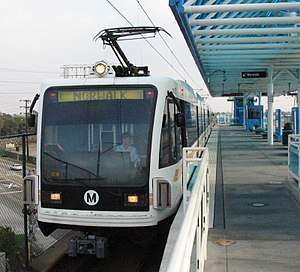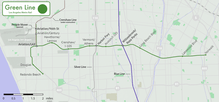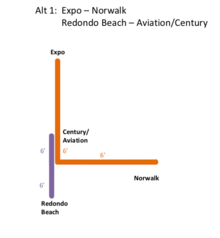Green Line (Los Angeles Metro)
|
| ||||||||||||||||||||||||||||||||||||||||||||||||||||||||||||||||||||||||||||||||||||||||||||||||||||||||||||||||||||||||||||||||||||||||||||||||||||||||||||||||||||||||||||||||||||||||||||||||||||||||||||||||||||||||||||||||||||||||||
 Metro Green Line train at Redondo Beach Station. | ||||||||||||||||||||||||||||||||||||||||||||||||||||||||||||||||||||||||||||||||||||||||||||||||||||||||||||||||||||||||||||||||||||||||||||||||||||||||||||||||||||||||||||||||||||||||||||||||||||||||||||||||||||||||||||||||||||||||||
| Overview | ||||||||||||||||||||||||||||||||||||||||||||||||||||||||||||||||||||||||||||||||||||||||||||||||||||||||||||||||||||||||||||||||||||||||||||||||||||||||||||||||||||||||||||||||||||||||||||||||||||||||||||||||||||||||||||||||||||||||||
|---|---|---|---|---|---|---|---|---|---|---|---|---|---|---|---|---|---|---|---|---|---|---|---|---|---|---|---|---|---|---|---|---|---|---|---|---|---|---|---|---|---|---|---|---|---|---|---|---|---|---|---|---|---|---|---|---|---|---|---|---|---|---|---|---|---|---|---|---|---|---|---|---|---|---|---|---|---|---|---|---|---|---|---|---|---|---|---|---|---|---|---|---|---|---|---|---|---|---|---|---|---|---|---|---|---|---|---|---|---|---|---|---|---|---|---|---|---|---|---|---|---|---|---|---|---|---|---|---|---|---|---|---|---|---|---|---|---|---|---|---|---|---|---|---|---|---|---|---|---|---|---|---|---|---|---|---|---|---|---|---|---|---|---|---|---|---|---|---|---|---|---|---|---|---|---|---|---|---|---|---|---|---|---|---|---|---|---|---|---|---|---|---|---|---|---|---|---|---|---|---|---|---|---|---|---|---|---|---|---|---|---|---|---|---|---|---|---|---|---|---|---|---|---|---|---|---|---|---|---|---|---|---|---|---|
| Owner | Metro Rail | |||||||||||||||||||||||||||||||||||||||||||||||||||||||||||||||||||||||||||||||||||||||||||||||||||||||||||||||||||||||||||||||||||||||||||||||||||||||||||||||||||||||||||||||||||||||||||||||||||||||||||||||||||||||||||||||||||||||||
| Transit type | Light rail | |||||||||||||||||||||||||||||||||||||||||||||||||||||||||||||||||||||||||||||||||||||||||||||||||||||||||||||||||||||||||||||||||||||||||||||||||||||||||||||||||||||||||||||||||||||||||||||||||||||||||||||||||||||||||||||||||||||||||
| Line number | 803 | |||||||||||||||||||||||||||||||||||||||||||||||||||||||||||||||||||||||||||||||||||||||||||||||||||||||||||||||||||||||||||||||||||||||||||||||||||||||||||||||||||||||||||||||||||||||||||||||||||||||||||||||||||||||||||||||||||||||||
| Number of stations | 14 | |||||||||||||||||||||||||||||||||||||||||||||||||||||||||||||||||||||||||||||||||||||||||||||||||||||||||||||||||||||||||||||||||||||||||||||||||||||||||||||||||||||||||||||||||||||||||||||||||||||||||||||||||||||||||||||||||||||||||
| Daily ridership | 36,141 (July 2016; avg. weekday)[1][2] | |||||||||||||||||||||||||||||||||||||||||||||||||||||||||||||||||||||||||||||||||||||||||||||||||||||||||||||||||||||||||||||||||||||||||||||||||||||||||||||||||||||||||||||||||||||||||||||||||||||||||||||||||||||||||||||||||||||||||
| Website | Green Line | |||||||||||||||||||||||||||||||||||||||||||||||||||||||||||||||||||||||||||||||||||||||||||||||||||||||||||||||||||||||||||||||||||||||||||||||||||||||||||||||||||||||||||||||||||||||||||||||||||||||||||||||||||||||||||||||||||||||||
| Operation | ||||||||||||||||||||||||||||||||||||||||||||||||||||||||||||||||||||||||||||||||||||||||||||||||||||||||||||||||||||||||||||||||||||||||||||||||||||||||||||||||||||||||||||||||||||||||||||||||||||||||||||||||||||||||||||||||||||||||||
| Began operation | August 12, 1995 | |||||||||||||||||||||||||||||||||||||||||||||||||||||||||||||||||||||||||||||||||||||||||||||||||||||||||||||||||||||||||||||||||||||||||||||||||||||||||||||||||||||||||||||||||||||||||||||||||||||||||||||||||||||||||||||||||||||||||
| Operator(s) | Los Angeles County Metropolitan Transportation Authority | |||||||||||||||||||||||||||||||||||||||||||||||||||||||||||||||||||||||||||||||||||||||||||||||||||||||||||||||||||||||||||||||||||||||||||||||||||||||||||||||||||||||||||||||||||||||||||||||||||||||||||||||||||||||||||||||||||||||||
| Character | Predominantly elevated and fully grade-separated, mostly in freeway median. | |||||||||||||||||||||||||||||||||||||||||||||||||||||||||||||||||||||||||||||||||||||||||||||||||||||||||||||||||||||||||||||||||||||||||||||||||||||||||||||||||||||||||||||||||||||||||||||||||||||||||||||||||||||||||||||||||||||||||
| Number of vehicles |
Siemens P2000 Kinkisharyo P3010 | |||||||||||||||||||||||||||||||||||||||||||||||||||||||||||||||||||||||||||||||||||||||||||||||||||||||||||||||||||||||||||||||||||||||||||||||||||||||||||||||||||||||||||||||||||||||||||||||||||||||||||||||||||||||||||||||||||||||||
| Train length | 1–2 vehicles | |||||||||||||||||||||||||||||||||||||||||||||||||||||||||||||||||||||||||||||||||||||||||||||||||||||||||||||||||||||||||||||||||||||||||||||||||||||||||||||||||||||||||||||||||||||||||||||||||||||||||||||||||||||||||||||||||||||||||
| Technical | ||||||||||||||||||||||||||||||||||||||||||||||||||||||||||||||||||||||||||||||||||||||||||||||||||||||||||||||||||||||||||||||||||||||||||||||||||||||||||||||||||||||||||||||||||||||||||||||||||||||||||||||||||||||||||||||||||||||||||
| System length | 20.0 mi (32.2 km)[3] | |||||||||||||||||||||||||||||||||||||||||||||||||||||||||||||||||||||||||||||||||||||||||||||||||||||||||||||||||||||||||||||||||||||||||||||||||||||||||||||||||||||||||||||||||||||||||||||||||||||||||||||||||||||||||||||||||||||||||
| No. of tracks | 2 | |||||||||||||||||||||||||||||||||||||||||||||||||||||||||||||||||||||||||||||||||||||||||||||||||||||||||||||||||||||||||||||||||||||||||||||||||||||||||||||||||||||||||||||||||||||||||||||||||||||||||||||||||||||||||||||||||||||||||
| Track gauge |
4 ft 8 1⁄2 in (1,435 mm) (standard gauge) | |||||||||||||||||||||||||||||||||||||||||||||||||||||||||||||||||||||||||||||||||||||||||||||||||||||||||||||||||||||||||||||||||||||||||||||||||||||||||||||||||||||||||||||||||||||||||||||||||||||||||||||||||||||||||||||||||||||||||
| Electrification | 750 V DC overhead catenary | |||||||||||||||||||||||||||||||||||||||||||||||||||||||||||||||||||||||||||||||||||||||||||||||||||||||||||||||||||||||||||||||||||||||||||||||||||||||||||||||||||||||||||||||||||||||||||||||||||||||||||||||||||||||||||||||||||||||||
| ||||||||||||||||||||||||||||||||||||||||||||||||||||||||||||||||||||||||||||||||||||||||||||||||||||||||||||||||||||||||||||||||||||||||||||||||||||||||||||||||||||||||||||||||||||||||||||||||||||||||||||||||||||||||||||||||||||||||||
The Green Line is a 20-mile (32 km)[3] light rail line running between Redondo Beach and Norwalk within Los Angeles County; it is one of six lines forming the Los Angeles Metro Rail system. The line opened on August 12, 1995. It became the third line in the Metro Rail system after the opening of the Blue Line and Red Line. The line was delayed due to a change of the line's route from Los Angeles International Airport to El Segundo. In addition to Redondo Beach and Norwalk, the route also serves El Segundo, Hawthorne, South Los Angeles, Lynwood, Downey, and Willowbrook (in South Los Angeles). It serves the Plaza Mexico shopping center at the Long Beach Boulevard station in the city of Lynwood. A free shuttle bus to Los Angeles International Airport (LAX) is available at the line's Aviation/LAX Station. The line is mostly suburb-to-suburb service, so it is the only one in the entire Metro Rail system not to serve Downtown Los Angeles.
The fully grade-separated route runs mostly in the median of the Century Freeway (Interstate 105) with a mostly elevated section to the west. The line is operated and maintained by the Los Angeles County Metropolitan Transportation Authority. The Green Line is internally known as Line 803: this designation appears on internal operating schedules, as well as in the hyperlink on Metro's timetable website. The Green Line is the fastest light rail line (excluding the heavy rail Red Line and Purple Line) in the Metro light rail network. Green Line trains typically operate at 55–65 mph on the I-105 freeway portion and around 40 mph on the elevated portion west of Aviation/LAX Station. When the Green Line began service in 1995, it operated with only one-car trains. As ridership increased, two-car trains were then used. Ridership on the Green Line has not been as high as the Blue Line, although it did have a higher ridership than the Gold Line until 2013.[1][2] Additionally, the Green Line runs with one-car trains in the early mornings (3:35 A.M.–5:30 A.M.) and late evenings (9:00P.M.–12:55 A.M.) on weekdays, and on weekends. Although nearly all of the Green Line stations were built to accommodate three rail cars, it has never had that many. The stations west of Aviation/LAX Station were not built to accommodate three-car trains. It is possible that the Green Line may eventually use three-car trains when the Crenshaw/LAX Line is complete.
Service description
Route

The entire route of the Green Line is elevated, either on track supports, or in the median of the Century Freeway (Interstate 105). The line begins in the west at Redondo Beach station, then heads roughly north through El Segundo. At Aviation/LAX, passengers can transfer to any one of several bus lines from different operators, particularly the shuttle bus to LAX. From here, the Green Line heads east in the median of the Century Freeway, with connection to the Metro Silver Line rapid transit at the Harbor Freeway Station. It then continues to a major transfer connection at the Willowbrook Station (transfer point to the Metro Blue Line). Finally, the line terminates in the city of Norwalk, just east of the 605 Freeway.
Hours of operation
Metro Green Line trains run between approximately 3:36 a.m. and 11:55 p.m. daily.[4] Service on Friday and Saturday nights continues until approximately 2:15 a.m. First and last train times are as follows:
To Norwalk Station
- Eastbound
- First Train to Norwalk from Willowbrook Station: 3:33 a.m.
- First Train to Norwalk from Douglas Station: 3:41 a.m.
- Last Train to Norwalk: 11:59 p.m. (2:01 a.m. Friday and Saturday nights)
To Redondo Beach Station
- Westbound
- First Train to Redondo Beach Station: 4:04 a.m.
- Last Train to Redondo Beach Station: 12:50 a.m. (2:12 a.m. Friday and Saturday nights))
Headways
Trains on the Green Line operate every seven to eight minutes during peak hours Monday through Friday.[5] They operate every 15 minutes during the midday and all day on the weekends, with night service running every 20 minutes.
History
As part of the consent decree signed by Caltrans in 1972 to allow construction of the fiercely opposed Century Freeway, provisions were made for a transit corridor (without designating the type thereof) in the freeway's median. In the original Metro Rail master plan of the early 1980s, this corridor was designated as a light rail line.
Mayor Tom Bradley and other politicians intended the line to be fully automated, running without operators, but the technology was not fully implemented in the end.[6]
Construction on the Green Line began in 1987. One of the reasons for construction was that the Green Line would serve the aerospace and defense industries in the El Segundo area. Construction of the line cost $718 million. By the time the Green Line opened in 1995, the Cold War was over, and the aerospace sector was hemorrhaging jobs. Furthermore, during the 1980s, the bedroom communities in the Gateway Cities region of southeastern Los Angeles County were rapidly losing their population of middle-class aerospace workers (primarily whites and blacks), a process that radically accelerated in the early 1990s. The working-class and poor Hispanics who filled the vacuum generally had no connection to the aerospace sector. This rationale for Green Line construction was a principal argument cited by the Bus Riders Union when it contended that the MTA was focusing its efforts on serving middle-class whites and not working-class minorities. As a result, ridership has been below projected estimates, averaging approximately 44,000 daily weekday boardings in June 2008.[1]
At the time the Green Line opened, the line used rolling stock made by Nippon Sharyo similar to that used on the Metro Blue Line. In late 2001, the Nippon Sharyo railcars were transferred to the Blue Line and the Green Line received new railcars made by Siemens.
The Green Line's western alignment was originally planned and partially constructed to connect with LAX, but the airport was planning a major renovation during the line's construction. Los Angeles World Airports wanted the connection to LAX to be integrated with this construction, but there were concerns from the Federal Aviation Administration that the overhead lines of the rail line would interfere with the landing paths of airplanes.[7] In addition, citizens of neighboring communities to LAX opposed the expansion of the airport. Taxi and limousine drivers and owners of parking lots surrounding LAX feared that a train operating to LAX would create competition, as there is ample free parking at numerous points along the Green Line. As a compromise, a free shuttle from Aviation/LAX Station transports riders to LAX terminals. Today, passengers on the Green Line can see the provision for the LAX extension—two concrete ramp stubs west of the Aviation/LAX station. These stubs are now being put into service as part of the Crenshaw Line.
The Green Line's eastern terminus also suffers from the fact that it stops two miles (3 km) just short of the heavily used Norwalk/Santa Fe Springs Metrolink station, where several Metrolink lines operate. Local bus service is provided between the Metrolink station and the Green Line terminus, but schedules are not coordinated with the Green Line arrivals. Because of this, and the Green Line's re-routed western alignment away from LAX, critics have labeled the Green Line as a train that goes "from nowhere to nowhere."[8] The Green Line is currently the only Metro rail line not to serve Downtown Los Angeles. Transfers to the Blue Line can be made at the Willowbrook Station by downtown-bound riders. However, many of these problems are being or will be solved with current and future construction projects. The Crenshaw Line, which is currently under construction, will connect to LAX’s terminal area via the future Aviation/96th station and an automated people mover. When the Crenshaw Line is completed, the Green Line will jointly serve part or all of this line. An extension to Norwalk/Santa Fe Springs Metrolink station is also planned for construction under Measure M.
Temporary closures of Green Line stations took place to allow renovations between early 2015 and early 2016.[9]
The entire line west of Hawthorne/Lennox was shut down for more than two months in early 2018 in order to build the junction with the Crenshaw/LAX Line.
Future extensions
Various studies have suggested extending the Green Line north to LAX, Westchester, Loyola Marymount University, and even Santa Monica. A possible southern extension could take the Green Line's southern terminus farther southeast, to the South Bay Galleria or beyond. And on the line's east end, the line may one day be extended from its current terminus at Norwalk station to Norwalk/Santa Fe Springs station.[10]
Integration with Crenshaw/LAX Line
In June of 2018, Metro staff recommended a new service pattern that would begin when the Crenshaw/LAX Line opened in late 2019. There would be two new services, both of which would run on parts of the existing Green Line and parts of the newly opened infrastructure:

- One service would connect Expo/Crenshaw and Norwalk, running along the newly built line, then turning at the wye, passing through Aviation/LAX and continuing along the existing Green Line.
- Another, shorter, service would connect Redondo Beach and the newly constructed Aviation/Century station, running mostly along the existing southwest section of the Green Line, then passing through the wye after Mariposa to briefly travel along the newly built line. This service would extend to Aviation/96th Street when that station opens.
At peak hours, both services would see 6 minute headways. The current G Shuttle bus connecting Metro Rail to the LAX terminals would shift from Aviation/LAX to the new closer Aviation/Century station, providing a connection for air travelers until the opening of the LAX Train and Aviation/96th in 2023.[11]
The arrangement is meant to provide a seamless rail option for the many passengers who currently transfer between the Green Line and north-south bus lines in the area, as well as operationally combine the Norwalk-LAX and Crenshaw/Expo-LAX legs, which have matching capacity needs, rather than combining either with the Redondo Beach leg. Operating all three potential routes through the wye (Redondo-Expo, Norwalk-Expo, and Norwalk-Redondo) would require increased headways and result in longer trip times, and capacity constraints on the Crenshaw/LAX Line infrastructure ruled out Crenshaw operating as a frequent-service trunk feeding both ends of the current Green Line.
Metro staff stated that operational patterns may change with the future opening of extensions south from Redondo Beach to Torrance or north from Expo/Crenshaw to Hollywood. The full Metro board has yet to approve the proposals,[12] which were met with resistance from some board members, particularly Supervisor Janice Hahn. The board will come to a decision on the routing later in 2018.[13]
Previous proposals had suggested that a new line would operate between Expo/Crenshaw station in the north and Redondo Beach in the south, with Green Line trains alternately serving the stretch southwest of the wye and the short section between the wye and Aviation/96th Street.[14][15]
Southern Extension to South Bay
Metro is currently working on the initial environmental study of a corridor extension of the Green Line, from its Redondo terminus toward the southeast. The "South Bay Metro Green Line Extension" would roughly follow the Harbor Subdivision ROW into the South Bay, to the Torrance Regional Transit Center (RTC).[16] Metro and the public are considering two alternatives in the DEIR: an elevated light-rail extension, and an at-grade extension over existing tracks, with vehicle type still to be determined.
Study of the South Bay Extension will lead to publication of a Draft Environmental Impact Report (DEIR). The study is expected to be completed in 2011. The project is prioritized in the Long Range Transportation Plan (LRTP) and has funding in Measure R[17] and the timeline is expected to be accelerated under the Twenty-eight by '28 inititative.[18]
Station listing
The Green Line consists of the following 14 stations (from west to east):
| Station | Station Connections | Date Opened | Station Parking | City/ Neighborhood |
|---|---|---|---|---|
| Redondo Beach | Metro Local: 126, 215 Beach Cities Transit 102 LADOT Commuter Express: 438, 574 Lawndale Beat Express, Residential Routes |
August 12, 1995 | 403 Spaces | Hawthorne |
| Douglas | Metro Local: 125
Amtrak California Thruway Motorcoach: Route 1C |
August 12, 1995 | 30 Spaces | El Segundo |
| El Segundo | LADOT Commuter Express: 574 Torrance Transit: 8 |
August 12, 1995 | 91 Spaces | |
| Mariposa | Metro Local: 232 Torrance Transit: 8 |
August 12, 1995 | No parking | |
| Aviation/LAX | Metro Local: 40 (Late Night/ Owl service only), 120, 625 LAX Shuttle: Route G (serves LAX Terminals 1-8 and the Tom Bradley International Terminal) Santa Monica Transit: 3, Rapid 3 Culver City Transit: 6, Rapid 6 Beach Cities Transit: 109 Gardena Transit: 5 LADOT Commuter Express: 438 |
August 12, 1995 | 390 Spaces | Westchester |
| Hawthorne/Lennox | Metro Local: 40, 126, 212, 312 Metro Express: 442 Metro Rapid: 740 The Link: Lennox Shuttle |
August 12, 1995 | 623 Spaces | Hawthorne |
| Crenshaw | Metro Local: 126, 207 (Weekdays selected Rush Hour AM/PM trips, & Weekends Only), 210 Metro Rapid: 710, 757 Torrance Transit: 5, 10 |
August 12, 1995 | 513 Spaces | |
| Vermont/Athens | Metro Local: 204, 206, 209 Metro Rapid: 754 Gardena Transit: 2 |
August 12, 1995 | 155 Spaces | Athens |
| Harbor Freeway | Metro Local: 45, 81, 120 Metro Express: 550 Metro Rapid: 745 LADOT Commuter Express: 448 Orange County Transportation Authority: 721 Gardena Transit: 1X Torrance Transit: 1, 2, 4 |
August 12, 1995 | 253 Spaces | South Los Angeles |
| Avalon | Metro Local: 48, 51, 52, 53, 351 LADOT DASH: Watts The Link: Willowbrook Shuttle |
August 12, 1995 | 158 Spaces | |
| Willowbrook | Metro Local: 55, 120, 202, 205, 355, 612 Gardena Transit: 5 LADOT DASH: Watts Lynwood Breeze Route D The Link: Willowbrook Shuttle: A, B, King Medical Center |
August 12, 1995 | 231 Spaces | Willowbrook |
| Long Beach Boulevard | Metro Local: 60, 251 Metro Rapid: 760 Lynwood Trolley: A |
August 12, 1995 | 646 Spaces | Lynwood |
| Lakewood Boulevard | Metro Local: 117, 265, 266 | August 12, 1995 | 414 Spaces | Downey |
| Norwalk | Metro Local: 111, 115, 120, 125, 311 Metro Express: 460, 577X Norwalk Transit: 2, 4, 5, 7 Long Beach Transit: 172, 173 |
August 12, 1995 | 1,792 Spaces | Norwalk |
Operations
Maintenance facilities
The Green Line is operated out of the Division 22 Yard (Aviation Street Yard). This yard stores the fleet used on the Green line. It is also where light maintenance is done on the fleet (Heavier maintenance is done at the Blue Line yard in Long Beach). The Yard is located between Redondo Beach and Douglas stations. Trains enter the yard via a junction halfway between the two stations. Douglas bound trains (Northbound) may enter but there is no exit track to continue North. Redondo Beach bound trains (Southbound) may enter and exit the Yard to continue south.
Rolling stock
At the time the Green Line opened, the line used rolling stock made by Nippon Sharyo similar to those used on the Metro Blue Line. In late 2001, the Nippon Sharyo P2020's were transferred to the Blue Line, and the Green Line received new Siemens P2000 railcars which have been operating on the Green Line ever since. Kinki Sharyo P3010 trains are also used, but are slowly entering service on the line.
Incidents
On February 22, 2015, a train near the Hawthorne/Lennox station struck and killed a man who was trespassing onto the tracks.[19][20]
Photo gallery
- Mariposa Station information stands.
- Metro Green Line route map on a Siemens P2000 train.
- Metro Green Line train heading to Redondo Beach Station arriving at Douglas Station.
- Redondo Beach Station is currently the western terminus of the Metro Green Line.
References
- 1 2 3 "Ridership Statistics - Rail Ridership Estimates". Los Angeles County Metropolitan Transportation Authority. August 20, 2013. Retrieved 2013-08-25.
- 1 2 "Monthly Ridership Plot" (PDF). Los Angeles County Metropolitan Transportation Authority. November 2013. Retrieved 2013-11-16.
- 1 2 "Facts at a Glance". Los Angeles County Metropolitan Transportation Authority. Retrieved 2013-11-16.
- ↑ "Green Line timetable" (PDF). Los Angeles County Metropolitan Transportation Authority. June 24, 2018. Retrieved 2018-07-16.
- ↑ "Metro Bus & Rail System Map" (PDF). Los Angeles County Metropolitan Transportation Authority. December 2013. Retrieved 2014-01-15.
- ↑ DAVID WILLMAN (January 11, 1993). "Vision of Automated Green Line Fading : Transportation: After spending $60 million for the driverless system, officials are seeking $5 million to modify it to carry conventionally operated cars". Los Angeles Times.
- ↑ Maddaus, Gene (January 9, 2008). "Why Green Line stopped short of LAX". Los Angeles Daily News. Retrieved September 2, 2016.
- ↑ Groves, Martah (October 8, 2005). "MTA's Plan for Westside Transit Line Detours South". Los Angeles Times. Retrieved 2013-11-17.
- ↑ "Green Line Upgrades". Metro. Retrieved 2015-05-30.
- ↑ http://www.latimes.com/local/california/la-me-transit-gap-20160110-story.html
- ↑ http://thesource.metro.net/2018/06/18/report-explains-operating-plan-for-crenshaw-lax-line-and-green-line/
- ↑ https://la.streetsblog.org/2018/06/22/crenshaw-green-line-operations/
- ↑ https://la.curbed.com/2018/7/3/17528832/metro-crenshaw-line-lax-green-line-connection
- ↑ Sumers, Brian (January 21, 2014). "Metro breaks ground on new $2 billion L.A. Crenshaw/LAX Line". Daily Breeze. Retrieved 31 January 2016.
- ↑ "City Council approves long-awaited people mover to LAX". Los Angeles Times. April 11, 2018. Archived from the original on April 12, 2018. Retrieved April 12, 2018.
- ↑ "Exploring The South Bay Metro Green Line Extension". KCET. Archived from the original on November 21, 2013. Retrieved November 18, 2013.
- ↑ "South Bay Metro Green Line Extension". Los Angeles County Metropolitan Transportation Authority. October 10, 2011. Retrieved 2013-11-17.
- ↑ Sharp, Steven (27 November 2018). "Here are the 28 Projects that Metro Could Complete Before the 2028 Olympics". Urbanize. Retrieved 2 July 2018.
- ↑ "PEDESTRIAN FATALLY STRUCK BY GREEN LINE TRAIN IN HAWTHORNE". ABC7. February 23, 2015. Retrieved 2015-10-20.
- ↑ "Man struck, killed by Metro Green Line train in Hawthorne". Daily Breeze (February 23, 2015). Retrieved 2015-10-20.
External links
Route map:
